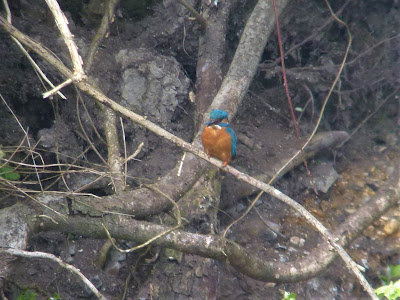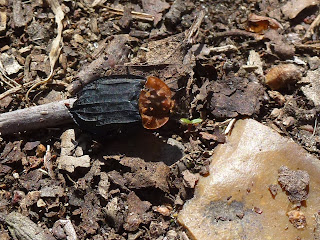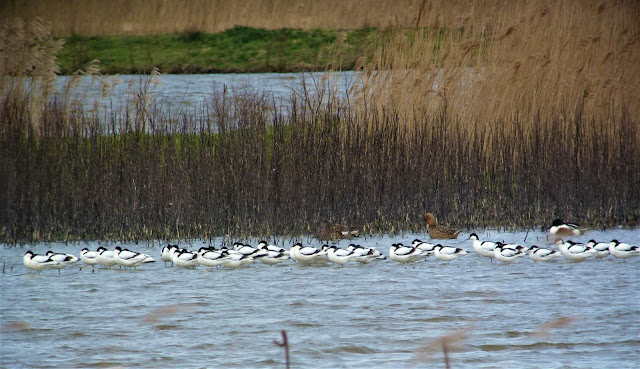Sunshine
with a cool northerly breeze greeted this week’s Honeyguide group, with Rob
Lucking, around the grazing marshes of Burnham Norton at the western end of Holkham
National Nature Reserve (NNR).
 |
| Grazing marshes at Burnham Norton. |
A
great white egret was out on the marshes, though it was displaying waders that
stole the show. Calling redshanks rose and twisted on angled wings; lapwings
tumbled and others could be picked out on the ground sitting on nests. There
were oystercatchers, too, and a few curlews.
Paul
Eele, warden of the NNR and a former RSPB colleague for Rob and me, came past
and paused for a chat. He confirmed that the water channels on the grazing
marsh had been enhanced by a rotary digger, here in the natural-looking
shapes of creeks
of the saltmarsh that it once was, centuries ago. In what is becoming a very
dry April, Paul also told us that this old grazing marsh was retaining its
water much better than marshes that are more recent reversions from arable to
grass.
It
was a good morning for mammals. At the back of the group, Helen and others saw
a weasel cross the path. There was hare to our right and a Chinese water deer
scampered across the marshes to our left before disappearing into reeds. Later,
Ann saw an otter on the gravel by a gate in the marshes; two others managed to
see it before it went out of sight into a ditch.
We heard a sedge warbler but we failed to find the yellow wagtail that
Rob saw briefly. Later we found a singing sedge warbler that stayed where it
was to allow good views through telescopes. Marsh harriers were constantly on
the move. Then two more very good birds: the first was a bittern that boomed, albeit not
often. The second was an immature little gull that was flying over a flooded area among a much
larger group of black-headed gulls. We found it again on the return leg of our
walk, including settled on the water. The dark lines on the upper wing means it
was a first-winter bird, and it lacked the smoky underwing of the long-staying adult
little gull at my local patch of NWT Thorpe Marshes (photos from Thorpe here).
At
the farthest point of this fairly gentle circuit we overlooked saltmarsh out towards
Scolt Head and inland towards Brancaster Overy Staithe. Avocets were feeding in
creeks and a flock of brent geese flew towards us and settled.
 |
| View over saltmarsh towards Scolt Head. |
The
sea walls were dominated by alexanders coming into flower, on which were many
ladybirds. There were mason bees in the dry path and one I photographed on
alexanders I think was grey-patched mining bee Andrena nitida.
 |
| Grey-patched mining bee (provisional ID). |
On
the lagoons on this part of the walk we added shovelers, teals and tufted ducks
to the gadwalls and shelducks seen already. Little egrets go almost without
comment nowadays and the great white egret returned.
We
said farewell to Honeyguiders not staying on for the afternoon; those out for
the day had their picnic lunches in the sunshine by the cars, under the willows
with the singing chiffchaff. Swallows came over us here.
A
short drive took us to Lady Anne’s Drive at Holkham which was busy with people,
as were the machines issuing tickets for parking. The popularity of Holkham
beach means birds are acclimatised to people and the sculpted channels and scrapes
in the marshes either side of the road had plenty of birds, offering close
views. These include more displaying redshanks and lapwings, a snipe, close
curlews, some late wigeons and more brent geese. After visiting loos at The
Lookout café, we walked along the back of the pines and immediately lost the
crowds who were obviously here for the beach.
It
was sheltered and warm and that brought out butterflies, three that were first-of-the-year
for most of us. A male orange tip flew past, then a green-veined white settled
on a flowering currant. The third was a speckled wood, dancing around a stump.
Peacock butterflies dashed past as well and a willow warbler sang. A marsh
harrier called; the male was high above us, over the Corsican pines, in courtside
display.
 |
| Holm oak leaves: the bumps are Aceria ilicis mite galls, the brown patches are leaf miners. |
We
noted how holm leaves were scarred with the tunnels of leaf miners. Then Rob
showed us an odd tree planted here long ago: winged elm, also called
cork-winged elm on this
Holkham blog; the photo shows why it is so named. Wahoo is another name given
on Wikipedia for Ulmus alata, introduced from North America.
 |
| Winged elm. |
Some turned back before
we reached the far (and closed) hide that overlooks the cormorant colony and
heronry. The others didn’t miss much: two spoonbills in flight only and no
egrets on view, just cormorants and woodpigeons. We paused on the return walk
to see what we’d earlier noticed a Naturetrek group observing: the larval pits
of antlions, a relatively recent colonist here. The slippery sides of the pits,
for trapping and consuming ants, recalled the sarlacc in the Star Wars film Return of the Jedi.
 |
| Antlion larval pit. |
We all returned
to the cars at much the same time and were able to enjoy a good view of a red
kite over the marshes. How amazing that red kite, marsh harrier and buzzard
should all be routine sightings – a transformation within our lifetimes.
We then drove a little
farther west for a brief visit to North Point wetlands at Wells-next-the-Sea (previously
visited by Honeyguide on a much chillier 1
April). There were many hares on the fields and waders on the lagoons, including
black-tailed godwits and ruffs, but we couldn’t find the reported grey
phalarope. A spoonbill and a red kite flew over. |
| Wells North Point wetlands, one of the lagoons. |
Chris
Durdin






























